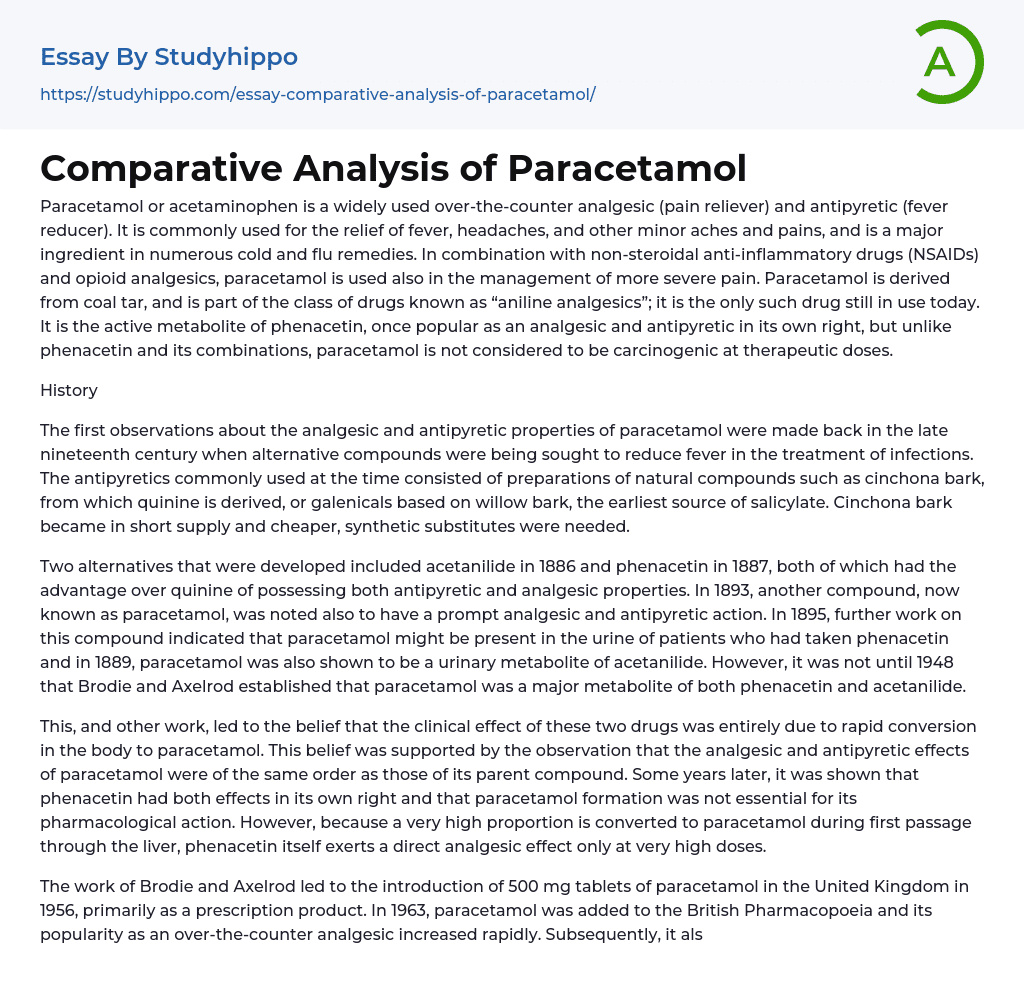Paracetamol or acetaminophen is a widely used over-the-counter analgesic (pain reliever) and antipyretic (fever reducer). It is commonly used for the relief of fever, headaches, and other minor aches and pains, and is a major ingredient in numerous cold and flu remedies. In combination with non-steroidal anti-inflammatory drugs (NSAIDs) and opioid analgesics, paracetamol is used also in the management of more severe pain. Paracetamol is derived from coal tar, and is part of the class of drugs known as “aniline analgesics”; it is the only such drug still in use today. It is the active metabolite of phenacetin, once popular as an analgesic and antipyretic in its own right, but unlike phenacetin and its combinations, paracetamol is not considered to be carcinogenic at therapeutic doses.
History
The first observations about the ana
...lgesic and antipyretic properties of paracetamol were made back in the late nineteenth century when alternative compounds were being sought to reduce fever in the treatment of infections. The antipyretics commonly used at the time consisted of preparations of natural compounds such as cinchona bark, from which quinine is derived, or galenicals based on willow bark, the earliest source of salicylate. Cinchona bark became in short supply and cheaper, synthetic substitutes were needed.
Two alternatives that were developed included acetanilide in 1886 and phenacetin in 1887, both of which had the advantage over quinine of possessing both antipyretic and analgesic properties. In 1893, another compound, now known as paracetamol, was noted also to have a prompt analgesic and antipyretic action. In 1895, further work on this compound indicated that paracetamol might be present in the urine of patients who
had taken phenacetin and in 1889, paracetamol was also shown to be a urinary metabolite of acetanilide. However, it was not until 1948 that Brodie and Axelrod established that paracetamol was a major metabolite of both phenacetin and acetanilide.
This, and other work, led to the belief that the clinical effect of these two drugs was entirely due to rapid conversion in the body to paracetamol. This belief was supported by the observation that the analgesic and antipyretic effects of paracetamol were of the same order as those of its parent compound. Some years later, it was shown that phenacetin had both effects in its own right and that paracetamol formation was not essential for its pharmacological action. However, because a very high proportion is converted to paracetamol during first passage through the liver, phenacetin itself exerts a direct analgesic effect only at very high doses.
The work of Brodie and Axelrod led to the introduction of 500 mg tablets of paracetamol in the United Kingdom in 1956, primarily as a prescription product. In 1963, paracetamol was added to the British Pharmacopoeia and its popularity as an over-the-counter analgesic increased rapidly. Subsequently, it also became an ingredient of compound analgesics, being combined with such centrally-acting compounds as codeine, dihydrocodeine and dextropropoxyphene, as well as with oral decongestants in a variety of formulations for the relief of the symptoms of the common cold, influenza and sinusitis.
Synthesis
Compared with many other drugs, paracetamol is much easier to synthesize, because it lacks stereocenters. As a result, there is no need to design a stereo-selective synthesis. Industrial preparation of paracetamol usually proceeds from nitrobenzene.
A one-step reductive acetamidation reaction can be mediated by thioacetate. Paracetamol may be easily prepared in the laboratory by nitrating phenol with sodium nitrate, separating the desired p-nitrophenol from the ortho- byproduct, and reducing the nitro group with sodium borohydride. The resultant p-aminophenol is then acetylated with acetic anhydride. In this reaction, phenol is strongly activating, thus the reaction only requires mild conditions.
- Cocaine essays
- Why Marijuana Should Be Legalized essays
- Drug Abuse essays
- Teenage Drug Abuse essays
- Board Of Directors essays
- Brand Management essays
- Business Ethics essays
- Business Management essays
- Change Management essays
- Comparative Analysis essays
- Decision Making essays
- Dispute Resolution essays
- Knowledge Management essays
- Leadership essays
- Leadership and Management essays
- Manager essays
- Operations Management essays
- Performance Management essays
- Product Management essays
- Project Management essays
- Quality Management essays
- Risk essays
- Risk Management essays
- Scientific Management essays
- Stress Management essays
- supply chain management essays
- Time Management essays
- Total Quality Management essays
- alternative medicine essays
- Aspirin essays
- Cannabis essays
- Cardiology essays
- Cloning essays
- Dentist essays
- drugs essays
- Hemoglobin essays
- Medical essays
- Medical Ethics essays
- Organ Donation essays
- Patient essays
- Pharmacology essays
- Plastic Surgery essays
- Surgery essays
- Therapy essays
- Vaccines essays
- Automotive essays
- Automotive Industry essays
- Commerce essays
- Construction essays
- E Commerce essays




